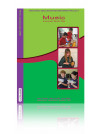In 2008, the second year of the fourth cycle of national monitoring, three areas were assessed: music, aspects of technology, and reading and speaking. This report presents details and results of the assessments of music.
A framework for music education and its assessment is presented in Chapter 2. It highlights two major content areas of learning in music: knowing and making music (which includes creating, playing and singing music), and knowing and responding to music (which includes interpreting music, moving in response to music, and analysing and appreciating music). It also identifies a range of musical skills to be developed and important aspects of student motivation and involvement with music.
New Zealand’s National Education Monitoring Project commenced in 1993, with the task of assessing and reporting on the achievement of New Zealand primary school children in all areas of the school curriculum. Children are assessed at two class levels: year 4 (halfway through primary education) and year 8 (at the end of primary education). Different curriculum areas and skills are assessed each year, over a four-year cycle. The main goal of national monitoring is to provide detailed information about what children know, think and can do, so that patterns of performance can be recognised, successes celebrated, and desirable changes to educational practices and resources identified and implemented.
Each year, random samples of children are selected nationally, then assessed in their own schools by teachers specially seconded and trained for this work. Task instructions are given orally by teachers, through video presentations, on laptop computers, or in writing. Many of the assessment tasks involve the children in the use of equipment and materials. Their responses are presented orally, by demonstration, in writing, in computer files, or through other physical products. Many of the responses are recorded on videotape for subsequent analysis.
Key Results
On average, year 8 students performed modestly better than year 4 students on tasks that involved creating, playing or singing music, but substantially better on tasks involving interpreting, analysing, appreciating or moving to music. The largest differences tended to occur on tasks that required interpretation of standard musical notation or knowledge of particular styles of music, and the smallest differences on singing tasks. In some cases, year 4 students performed better in displaying vitality and colour in performance.
Overall, performance in music did not improve or decline meaningfully between 2004 and 2008. The evidence from the four assessments of music over the past 12 years suggests a small improvement in performance over these 12 years for year 4 students and little or no change for year 8 students.
The relative popularity of music compared to other school subjects has not changed over the past 12 years, and participation levels in music lessons or groups outside of school have been maintained or slightly increased. Involvement in music activities beyond school is particularly high for year 4 Pasifika students. Girls were clearly more positive about musical activities than boys, and Pasifika students than Pakeha students. Listening to music (for year 4 students) and moving or dancing to music (for both year levels) have become more common in school music programmes.
Differences in music performance among demographic subgroups were substantially lower than in most other subject areas. At both year levels, girls typically performed a little better than boys, Pakeha students moderately better than Māori students, and Pakeha students slightly better than Pasifika students, but in all of these comparisons there was a huge overlap in performance, with an opposite trend on one task.

